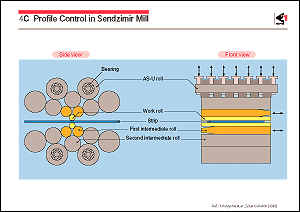| The Sendzimir mill is a rolling
mill with cluster rolls for cold rolling such hard materials
as stainless steel. Work rolls of small diameter are used to
apply a strong rolling force to hard materials, but this makes
it difficult to ensure the desired surface flatness. To solve
this problem, a cluster roll configuration and various profile
control units are adopted in the Sendzimir mill, which, as illustrated
in the figure, is equipped with the upper first and lower first
intermediate rolls which are tapered in one direction and are
capable of being shifted. In addition, six separate rolls are
installed at the top and bottom, together with two AS-U rolls.
The AS-U rolls are each supported by seven saddles which can
adjust the rolling load on each segment of the rolls. The AS-U
rolls can be displaced along their axes to a different extent
by the hydraulically driven saddles, resulting in a change in
the profile of the rolled material in these axial directions.
However, such a complicated roll structure and the large number
of operating factors result in a non-linear relationship between
the operating factors and the profile of the rolled material,
causing difficulty in quantification. For this reason, applications
of classical or modern control theories are not sufficient to
produce the desired effects. In the past, skilled workers visually
determined the profile of the strip at the delivery side and
operated the mills utilizing their experience and intuition.
The next section gives an example of how satisfactory results
can be obtained by applying the new control techniques of a neural
network and fuzzy logic as part of a new control system. |
|
 |
 |
 |
|
|